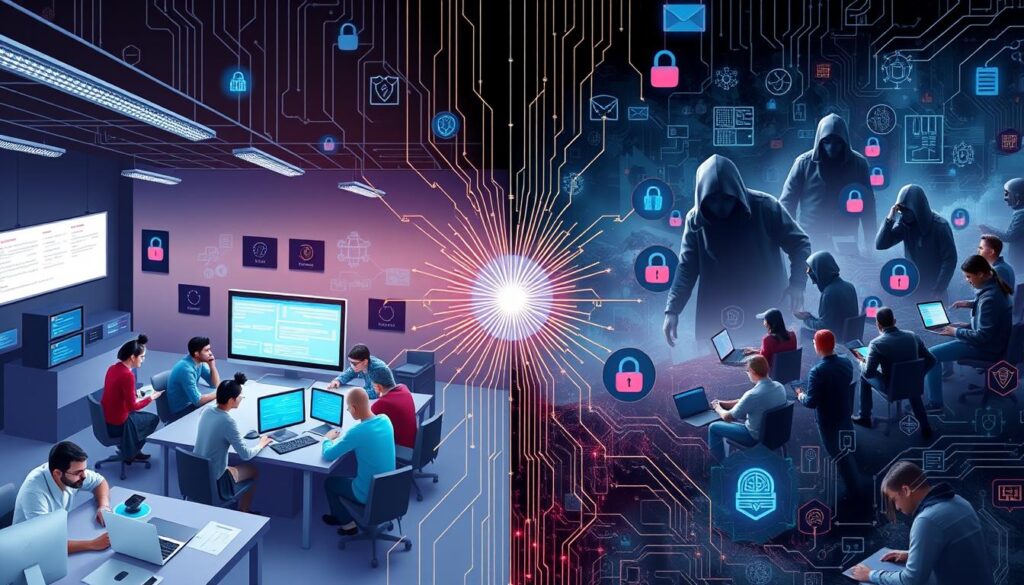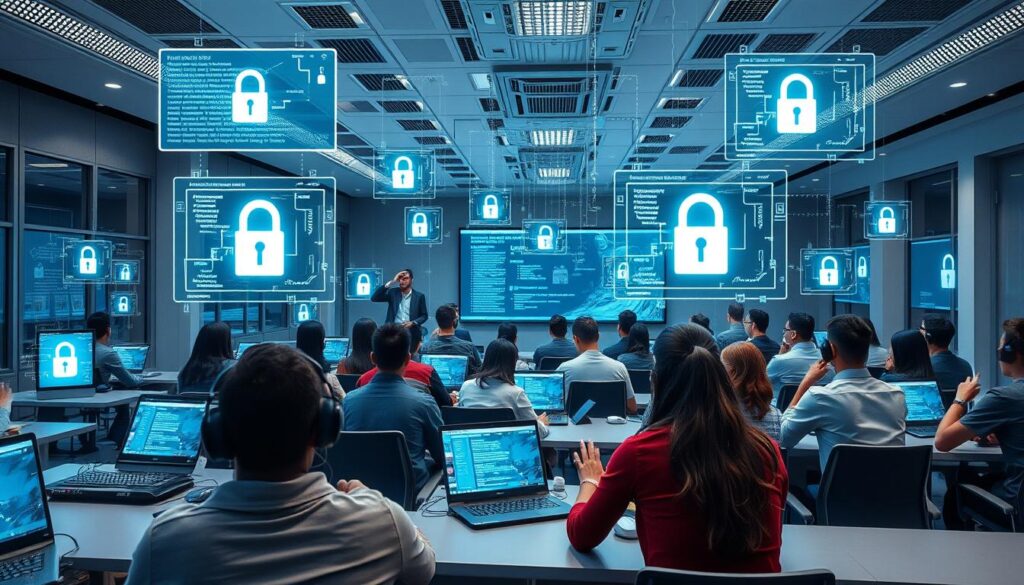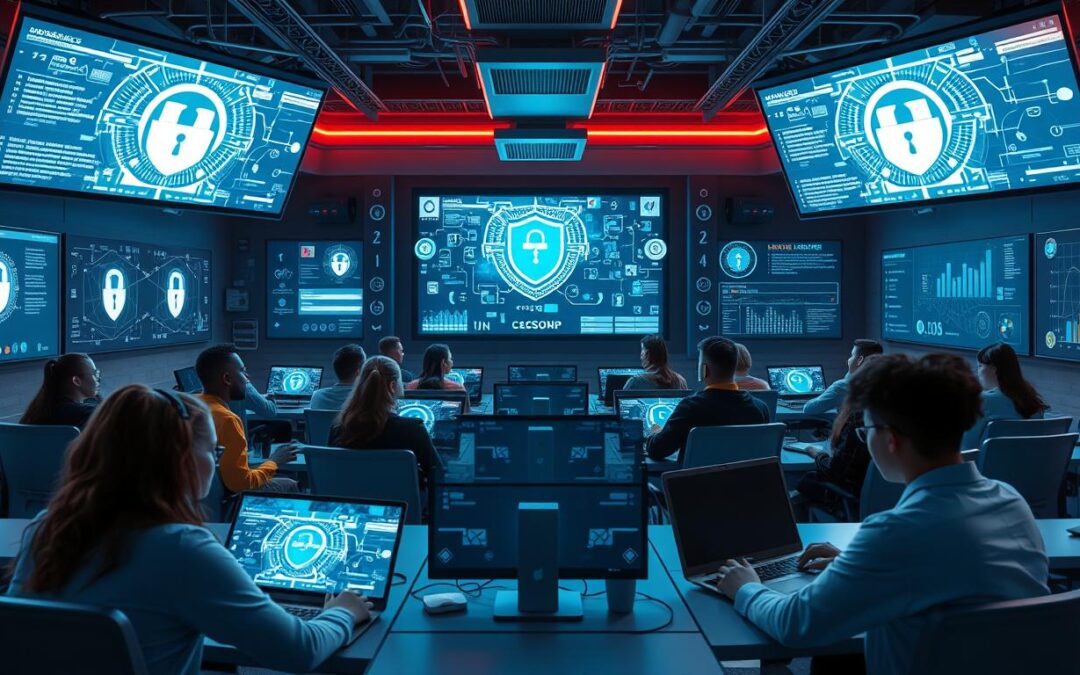The need for skilled cybersecurity experts is growing fast. Yet, the current workforce is struggling to meet this demand. This has led to a big cybersecurity skills gap. It’s a problem that affects both individuals and organizations.
Cybersecurity education is key to solving this issue. It teaches students the digital defense skills needed to thrive in the field. The cybersecurity workforce must have the right skills to fight off new threats.
As threats evolve, the need for a strong cybersecurity workforce grows. Investing in education can help close this gap. It gives people the skills to succeed in cybersecurity.
By supporting cybersecurity education, we can prepare the next generation. They will be ready to face the digital age’s challenges.
Introduction to Cybersecurity Skills Gap
Cybersecurity education is vital for students’ success in the field. The cybersecurity workforce is facing a big skills gap. Education can help fill this gap.
By teaching students the right digital defense skills, we prepare them for the future. This ensures the next generation of cybersecurity experts is ready for the digital age’s challenges.
Key Takeaways
- Cybersecurity skills gap is a significant challenge facing the cybersecurity workforce
- Cybersecurity education is essential for providing students with the necessary digital defense skills
- Investing in cybersecurity education can help bridge the digital defense divide
- The cybersecurity workforce needs professionals with the right skills to protect against evolving threats
- Cybersecurity education can help ensure that the next generation of cybersecurity professionals is equipped to handle the challenges of the digital age
- Cybersecurity education is critical for providing students with the skills they need to succeed in the field
Understanding the Current Cybersecurity Skills Gap
The cybersecurity job market is facing a big challenge. There’s a talent shortage leading to a skills deficit. This problem is not just in one place, but worldwide. Studies show that by 2025, there will be 3.5 million jobs without people to fill them.
This shortage affects businesses a lot. They struggle to find the right people for important cybersecurity jobs. The costs of not having the right people are high, with data breaches costing over $3.9 million on average. Finding the right people is key to solving this problem.
Global Shortage Statistics
- 3.5 million unfilled cybersecurity positions by 2025
- 64% of organizations report a shortage of cybersecurity skills
- The cybersecurity skills gap is expected to increase by 20% annually
Impact on Businesses and Organizations
The lack of skilled cybersecurity workers is a big problem for businesses. Without the right people, companies are at higher risk of cyberattacks and data breaches. To lower this risk, companies need to invest in training and attracting new talent.
Critical Areas Facing the Biggest Shortages
Cloud security, artificial intelligence, and incident response are the biggest shortages. These areas need special skills, making it hard to find the right people. Knowing where the problem is helps businesses create plans to fill these gaps and reduce risks.
| Critical Area | Shortage Percentage |
|---|---|
| Cloud Security | 75% |
| Artificial Intelligence | 60% |
| Incident Response | 55% |
The Growing Threat Landscape in Digital Security
The digital security world is getting more complex. are on the rise. This makes it crucial for companies to keep up.
Some major cyber threats include:
- Phishing attacks
- Ransomware
- Malware
- DDoS attacks
These threats are getting smarter. It’s vital for organizations to protect themselves.
Recent studies show more cyber threats are happening. Many companies are falling to evolving cybercrime. This shows the need for skilled cybersecurity experts.
By knowing the threat landscape, companies can protect their digital assets. They can stay ahead of cybercriminals.
| Type of Cyber Threat | Description |
|---|---|
| Phishing | A type of social engineering attack where attackers trick victims into revealing sensitive information |
| Ransomware | A type of malware that encrypts a victim’s files and demands a ransom in exchange for the decryption key |
| Malware | Software designed to harm or exploit a computer system |
By keeping up with cyber threats and digital security challenges, organizations can protect themselves. They can stay safe in the changing digital world.
Why Traditional Education Models Fall Short
Traditional education often fails to give students the cybersecurity curriculum and practical skills they need. This is because the field of cybersecurity changes fast. It can leave school programs behind.
The industry-academia gap is a big problem. It means graduates might not be ready for what employers need. To fix this, schools must offer training that includes the newest cybersecurity tools and methods.
Some major issues with old education models are:
- Curricula that don’t keep up with new industry trends
- Not enough practical experience and hands-on training
- Hard to keep up with the fast-changing world of cybersecurity
We can start to find better ways to teach by focusing on practical skills and training that matters to the industry. This will help close the industry-academia gap. It will also get students ready for careers in cybersecurity.
| Challenge | Solution |
|---|---|
| Outdated curricula | Regularly update curricula to reflect industry developments |
| Lack of practical experience | Provide hands-on training and internships |
| Industry-academia gap | Foster partnerships between educational institutions and industry leaders |
Essential Cybersecurity Skills Needed in Today’s Market
To succeed in cybersecurity, you need both technical and soft skills. These skills help protect networks, systems, and data from threats. Key technical skills include network security, cryptography, and threat analysis.
Soft skills like problem-solving, communication, and adaptability are also crucial. Cybersecurity pros must solve complex problems, communicate well, and adapt to new threats. By possessing these skills, they can keep their organizations safe.
Some top cybersecurity skills include:
- Cloud security
- Artificial intelligence and machine learning
- Incident response
- Security information and event management (SIEM)
By focusing on these skills, you can build a strong career in cybersecurity. Organizations can also protect their assets with the right talent. As threats evolve, staying current with cybersecurity skills is key.
Modern Educational Pathways for Cybersecurity Careers
Cybersecurity education has changed a lot, offering many ways to start a career in this field. With more jobs available, it’s key to find the right path for you. This will match your goals and interests.
Thinking about professional development is important when choosing your education. Traditional degrees like bachelor’s or master’s in cybersecurity are well-liked by employers. But, they take a lot of time and money.
Bootcamps and short training courses are becoming more popular. They focus on specific skills like penetration testing and can be finished quickly.
Online courses and certifications are great for those who like to learn at their own speed. They’re often cheaper than traditional degrees. Certifications like CompTIA Security+ and CISSP are very popular.
- Traditional degree programs
- Bootcamps and intensive training
- Professional certifications
- Self-paced online learning
Choosing the right education depends on your needs and goals. By looking at all the options, you can make a smart choice. This will help you succeed in cybersecurity, improving your career pathways through ongoing professional development and staying current with new cybersecurity education options.
Bridging the Cybersecurity Skills Gap Through Education
To tackle the cybersecurity skills gap, we need to create educational solutions that meet industry demands. This means focusing on skill development strategies that offer practical, hands-on training. Such training helps individuals gain the skills needed to excel in cybersecurity, making our digital world safer.
Some effective strategies include:
- Offering workforce training that meets business needs
- Creating curricula that cover new cybersecurity technologies and trends
- Supporting ongoing learning through certifications and workshops
By using these methods, schools can help shape the next wave of cybersecurity experts. As the need for skilled cybersecurity professionals grows, it’s vital to focus on educational solutions that close the skills gap. This encourages a culture of ongoing learning and innovation.

Together, we can build a safer digital world where both individuals and organizations can flourish. By investing in skill development strategies and workforce training, we ensure the cybersecurity workforce is ready to face digital threats and challenges.
| Strategy | Benefits |
|---|---|
| Targeted educational solutions | Improved job prospects, enhanced skills |
| Skill development strategies | Increased confidence, better job performance |
| Workforce training programs | Enhanced productivity, reduced cybersecurity risks |
Industry-Academia Partnerships: A Critical Bridge
Working together, industry and academia can tackle the cybersecurity skills gap. Schools can make their programs more relevant and practical. This industry collaboration leads to specialized courses and training on new trends and tech.
Students get experiential learning through internships and projects. This lets them use what they learn in real situations. It helps them gain practical skills and build their professional network. Some great examples include:
- Microsoft’s partnership with universities to develop cybersecurity courses and training programs
- Cisco’s collaboration with educational institutions to create networking and cybersecurity curricula
- IBM’s internship programs for students, providing them with hands-on experience in cybersecurity and related fields
These partnerships help both students and industries. They create a flow of skilled professionals ready to face cybersecurity challenges. The role of industry collaboration and academic partnerships in shaping cybersecurity education is vital.
Through these partnerships, students get insights and skills for a cybersecurity career. Adding experiential learning to academic programs is key. It gives students the practical experience needed by the industry. As cybersecurity evolves, so will the need for industry collaboration and academic partnerships.
| Partnership | Benefits |
|---|---|
| Microsoft and universities | Development of specialized cybersecurity courses |
| Cisco and educational institutions | Creation of networking and cybersecurity curricula |
| IBM’s internship programs | Hands-on experience in cybersecurity and related fields |
Developing Practical Skills Through Hands-on Training
Practical cybersecurity training is key for those starting in the field. It uses simulated environments and capture-the-flag competitions. These methods make learning fun and effective, helping people tackle tough cybersecurity challenges.
Hands-on training offers many benefits:
- Improved problem-solving skills
- Enhanced understanding of cybersecurity concepts
- Increased confidence in responding to real-world threats
Real-world experience is vital in cybersecurity, where threats change all the time. By using simulated environments and hands-on training, people can learn the skills needed to keep up with threats. Practical cybersecurity training is now a must for anyone in this field.
Many places offer simulated environments and hands-on training. These programs help people learn the skills they need to succeed in cybersecurity. They provide a safe space to practice and apply what you’ve learned, making them key to any cybersecurity training.
Adding real-world experience to training gives people an edge in the job market. It keeps them updated with the latest threats and technologies. Whether through simulated environments, capture-the-flag competitions, or other hands-on methods, practical training is crucial for success in cybersecurity.
| Training Method | Benefits |
|---|---|
| Simulated Environments | Improved problem-solving skills, enhanced understanding of cybersecurity concepts |
| Capture-the-Flag Competitions | Increased confidence in responding to real-world threats, improved teamwork and communication skills |
| Hands-on Training | Real-world experience, improved understanding of cybersecurity technologies and threats |
The Role of Continuous Learning in Cybersecurity
Cybersecurity is always changing, with new threats and technologies popping up daily. To keep up, professionals must commit to lifelong learning. They need to keep their skills sharp by learning about the newest cybersecurity trends.
They must also focus on professional development. This means looking for training and education that keeps them current. Ways to do this include going to industry conferences, joining online forums, and getting certifications.

- Keeping up with the latest threats and vulnerabilities
- Learning about new technologies and tools
- Improving skills in areas like incident response and threat hunting
By making continuous learning and professional development a priority, cybersecurity pros can stay ahead. They’ll have the skills and knowledge needed to thrive in this fast-changing field. They’ll also keep up with the latest cybersecurity trends and advancements in lifelong learning.
Government Initiatives and Educational Support
The government is key in backing cybersecurity education and tackling the skills gap. They do this through cybersecurity policy and government funding. Many programs and funds aim to boost educational initiatives in cybersecurity. This helps both people and companies.
Some notable initiatives include:
- Grant programs for cybersecurity education and training
- Partnerships with industry leaders to develop curriculum and provide resources
- Scholarships and funding for students pursuing cybersecurity degrees
These efforts show the government’s dedication to a stronger cybersecurity workforce. They aim to create a culture of cybersecurity awareness. By supporting educational initiatives and offering government funding, they help fill the cybersecurity skills gap. This makes our digital world safer.
As the need for skilled cybersecurity pros keeps rising, the government must keep investing. They need to focus on cybersecurity policy and educational initiatives. This will help build a strong cybersecurity workforce.
Future Outlook for Cybersecurity Education
The future of cybersecurity is changing fast, thanks to emerging technologies. These changes will shape how we teach and train cybersecurity experts.
Some important areas to focus on include:
- Predicted skill requirements based on industry trends
- Adaptive learning methods to keep pace with evolving threats
- Integration of emerging technologies into educational programs
By embracing these changes and using adaptive learning, we can prepare the next cybersecurity experts. The future of cybersecurity looks bright, and it’s an exciting time to be part of it.
| Emerging Technology | Potential Impact on Cybersecurity Education |
|---|---|
| Artificial Intelligence | Enhanced threat detection and response |
| Machine Learning | Improved predictive analytics and risk assessment |
| Cloud Computing | Increased scalability and accessibility of educational resources |
Conclusion: Empowering the Next Generation of Cybersecurity Professionals
Education is key to empowering the next generation of cybersecurity experts. By using modern educational paths and partnerships, we can create a strong team of cybersecurity professionals. They will help protect our digital world.
The job outlook in cybersecurity is very good, with a 31% increase in jobs by 2029. This shows we need to focus on teaching people the right cybersecurity skills. With new training programs and hands-on learning, we can help people succeed in this field.
Working together, industry leaders and schools can make sure cybersecurity education stays up-to-date. This partnership will bring valuable internships, mentorship, and research. It will help prepare the next generation for the challenges ahead.
FAQ
What is the current state of the cybersecurity skills gap?
The world is facing a big problem with cybersecurity skills. There aren’t enough experts to keep digital security safe. This makes companies more vulnerable to threats.
How are evolving cyber threats impacting the need for skilled cybersecurity professionals?
Cyber threats are getting worse and more complex. This means we need people who can keep up and protect our digital world.
Why do traditional education models fall short in addressing the cybersecurity skills gap?
Old ways of learning can’t keep up with new tech fast enough. This means students don’t get the practical skills they need for cybersecurity jobs.
What are the essential skills needed for a successful career in cybersecurity?
You need technical skills like network security and problem-solving. Soft skills like communication and teamwork are also key. Having a mix of both is important.
What are the modern educational pathways available for those seeking a career in cybersecurity?
There are many ways to learn about cybersecurity. You can get a degree, take a bootcamp, get certified, or learn online. Each option has its own benefits.
How can industry-academia partnerships help bridge the cybersecurity skills gap?
Working together, schools and companies can make learning more relevant. They can offer internships and mentorship. This helps prepare students for real-world jobs.
Why is continuous learning important in the field of cybersecurity?
Cybersecurity changes fast, so you must keep learning. Staying current with new threats and tech is crucial. This keeps you ahead of cyber threats.
What is the role of government initiatives and educational support in addressing the cybersecurity skills gap?
Governments help by supporting cybersecurity education. They fund programs and create policies. This helps both job seekers and companies improve their security.
What is the future outlook for cybersecurity education?
The future of learning about cybersecurity will include new tech and practical training. Education will need to adapt to keep up with the industry’s growth.

